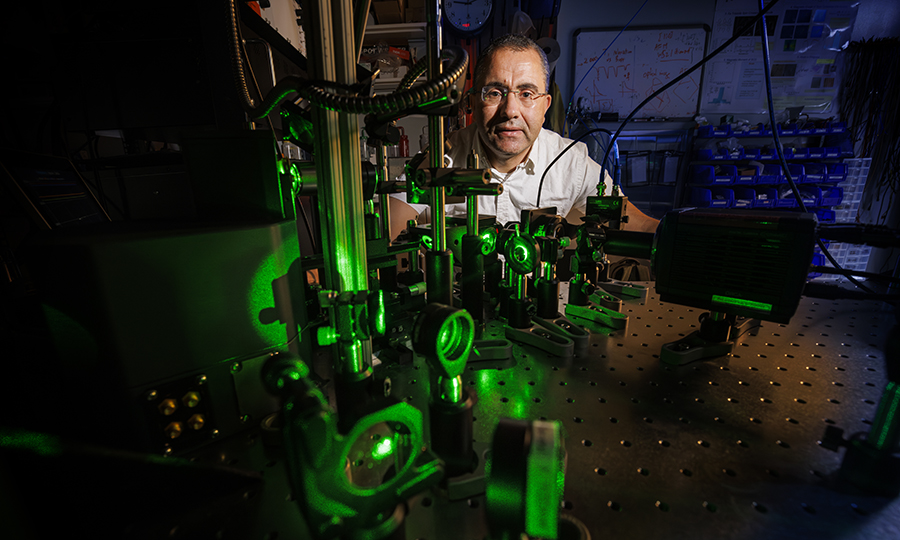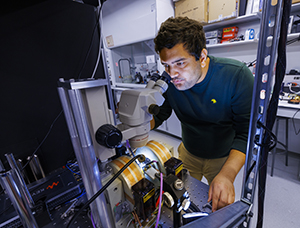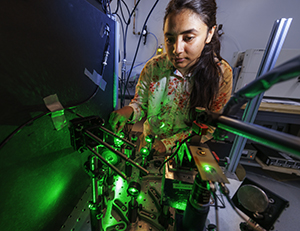Calendar Icon
Feb 28, 2024
![]() RSS
Submit a Story
RSS
Submit a Story

RELATED LINKS
Two papers recently published in esteemed journals outline how research teams in Abdelghani Laraoui's lab are using a quantum sensing technique his lab developed that could lead to big breakthroughs in data transport technologies and in treating diseases.
This research is supported by the National Science Foundation-funded Emergent Quantum Materials and Technologies (EQUATE), which “guides discoveries and expedites findings of new emergent quantum materials and phenomena for future quantum technologies.”
Published Dec. 23, 2023 in Advanced Electronic Materials, the first paper – “Mapping of Spin-Wave Transport in Thulium Iron Garnet Thin Films Using Diamond Quantum Microscopy” – outlines how the Nebraska team made the first documented measurements of how surface spin waves propagate in thin films of thulium iron garnet (TmIG). Spin waves, dynamic magnetic excitations in magnetic materials, behave in a similar way to water waves generated by throwing a stone in a lake.

Rupak Timalsina, a doctoral student in materials engineering, led the research in Laraoui’s Quantum Sensing & Defect Discovery and Spectroscopy Lab using diamond nitrogen-vacancy (NV) magnetometry to study the spin-wave transport properties in TmIG films.
Other members of the team include materials engineering graduate student Adam Erickson, and Nebraska physics professor Xiaoshan Xu and his graduate students Haohan Wang and Bharat Giri.
The use of TmIG, a more readily available rare-earth material, could help fill a demand for new magnetic materials with different properties that could be beneficial in spin-wave electronics, referred to as magnonics, and especially in quantum computing, said Laraoui, assistant professor of mechanical and materials engineering.
The next step, Laraoui said, is for researchers to harness the possibilities of spin waves in new materials to create a “quantum bus” that can more quickly and efficiently facilitate the quantum information transport between distant spin qubits, such as NVs.
“We used the NV layer as a quantum sensor to measure how these spin waves decay over space,” said Laraoui. “We expect to use these propagated spin waves to transport information from location A to location B.”
Using TmIG helps overcome big hurdles in upscaling these data transport processes and making technologies, such as quantum computing, more affordable, Laraoui said.
Currently, many of the new materials being used in quantum computers are hard to make and very expensive, and many of them work best in ultracold environments (cooler than 1 degree Kelvin) where there is less noise generated when spin qubits are excited. Laraoui said the magnetic properties of TmIG including topology, combined with a long spin-wave coherence length could work as an alternative material at slightly warmer temperatures (warmer than a few degrees Kelvin).
Laraoui said the NV methodology used also provides more accuracy in filtering and imaging of spin waves in ferrimagnetic insulators and two-dimensional magnets, pushing the spatial resolution from the current standard of about 500 nanometers to below 50 nanometers. This opens the door for NV magnetometry to be used in the study of complex interactions between topological spin textures such as skyrmions and spin waves.
“The ultimate goal is to get to functioning at ambient conditions because of thermal fluctuations. If you increase the temperature even one degree Kelvin, then you get so much more fluctuation and you lose information,” Laraoui said.
The second paper – “Nitrogen-Vacany Magnetic Relaxometery of Nanocluster Cytochrome C Proteins,” published in the Jan. 24 edition of Nano Letters – researchers also used NV layer as a quantum sensor to more accurately assess the performance of cytochrome C (Cyt-C) nanoclusters, which are water-soluble proteins that play a vital role in electron transport chains of mitochondria.

By varying the concentration of Cyt-C nanoclusters, researchers – led by physics graduate student Suvechhya Lamichhane - observed a reduction of the NV spin-lattice relaxation time affected by the rates of iron spin interactions within the proteins.
Other Nebraska members of the team include materials engineering graduate student Rupak Timalsina, Nebraska chemistry professor Rebecca Lai, chemistry postdoctoral researcher Cody Schultz and physics professor Sy-Hwayng Liou, along with Kapildeb Ambal from Wichita State University and Ilja Fescenko from the University of Latvia.
Laraoui said knowing the concentration variation of Cyt-C nanoclusters could help understand the causes of cellular inflammation and could lead to breakthroughs in research to find treatments for cancers, Parkinson’s disease, or malaria, among many.
“The NV quantum sensors could be used to detect an imbalance or deficiency of a substance, in this case iron, and that could be helpful in understanding what causes cellular damage,” Laraoui said. “It also requires the use of less material to do the analysis that could be completed in a matter of seconds instead of minutes or hours.”
By focusing on the iron in the Cyt-C nanocluster, researchers can use NV technique because iron is magnetic. Iron spins create noise that affects the NV spins and therefore can more accurately measure the iron density in greatly smaller scale and using smaller amounts, Laraoui said.
“The next step is to find the minimum Cyt-C concentration we can detect,” Laraoui said. “We’d like to go in vivo or (create) a microfluidic device that can help in detecting single proteins down to the size of a few nanometers, which is the size of Cyt-C monomers. This research shows that it’s possible, and that’s going to be a game-changer in so many ways.”
Submit a Story